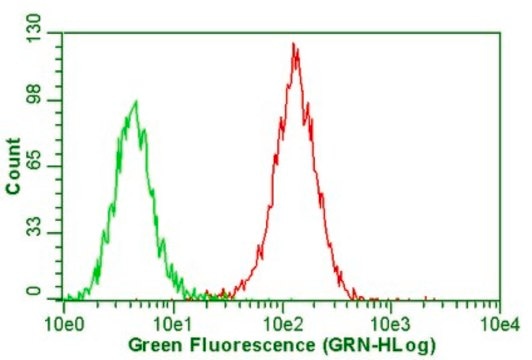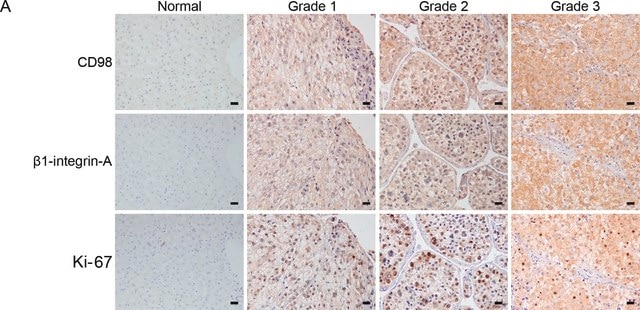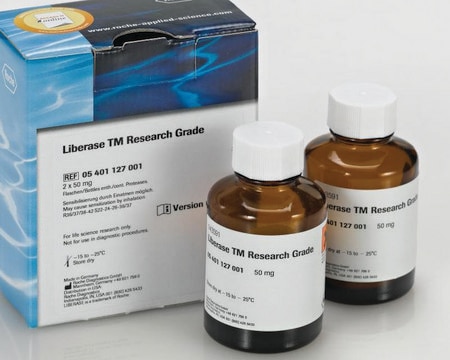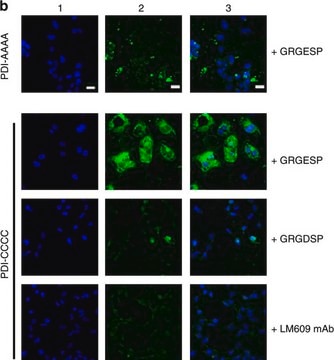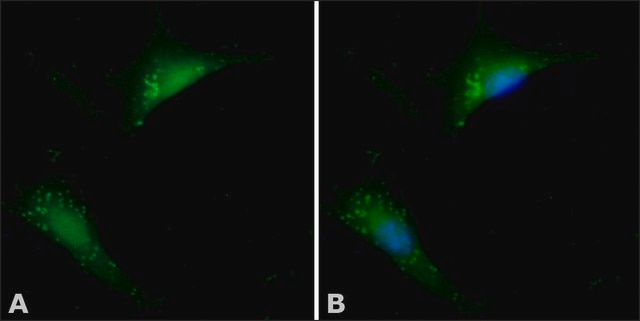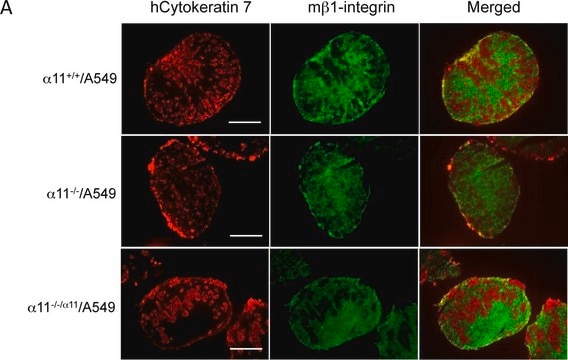General description
Integrin beta-1 (UniProt P05556; also known as CD29, Glycoprotein Iia, GPIIA, Integrin VLA-4 subunit beta, Very late activation protein, beta polypeptide) is encoded by the ITGB1 (also known as FNRB, MDF2, MSK12, VLA-BETA, VLAB) gene (Gene ID 3688) in human. Integrin beta-1 is a 130 kDa transmembrane glycoprotein that interact with various integrin alpha subunits (including alpha 1, alpha 2, alpha 3, alpha 4, alpha 5, and alpha 6) to form the functional receptor complexes that bind to specific extracellular matrix proteins. Integrin receptors regulate a variety of important biological functions, including embryonic development, wound repair, hemostasis, and prevention of programmed cell death. They are also implicated in abnormal pathological states such as tumor directed angiogenesis, tumor growth and metastasis. These heterodimeric receptors bridge the cytoplasmic actin cytoskeleton with proteins present in the extracellular matrix and/or on adjacent cells. Interactions between integrins and the extracellular matrix lead to the activation of signal transduction pathways and regulation of gene expression.
Specificity
Clone HUTS-4 is specific for active conformation of human beta1 integrins. The beta1 or VLA integrin subgroup contains at least 10 members, each with a distinct alpha subunit nonconvalently associated with the common beta1 subunit. Functional activation of integrins can be experimentally induced by addition of Mg2+ or Mn2+, or by using one of several stimulatory antibodies that are available. Intracellular signals generated as a result of cell activation also modulate the confirmation and affinity of integrins in cellular systems. Antibodies such as MAB2079Z which have the ability to discriminate between different states of integrin activation are exceptionally useful for studies on the regulation of activation. Antibody MAB2079Z recognizes epitopes in the 355-425 region of the common beta1 subunit of VLA integrins, whose expression parallels the ligand binding activity of these adhesion receptors induced by various extracellular and intracellular stimuli.
Immunogen
Epitope: A.a. 355-425 region of the common β1 subunit of VLA integrins.
Generated against human β1 integrins purified from Triton X-100 lysates of human lung, liver, and skeletal muscle tissues.
Application
Anti-Integrin β1 Antibody, activated, clone HUTS-4, Alexa Fluor™ 488 Conjugate is an antibody against Integrin β1 for use in Immunocytochemistry.
Immunocytochemistry Analysis: A 1:100 dilution from a representative lot detected Integrin β1 in A431 and NIH/3T3 cells.
The unconjugated antibody (Cat. No. MAB2079Z) is shown to be suitable also for Western blotting, ELISA, functional assay, and immunohistochemistry.
Research Category
Cell Structure
Research Sub Category
Adhesion (CAMs)
Quality
Evaluated by Immunocytochemistry in HeLa cells.
Immunocytochemistry Analysis: A 1:100 dilution of this antibody detected Integrin β1 in HeLa cells.
Target description
~88 kDa observed
Physical form
Protein G Purified
Purified mouse antibody conjugate in PBS with 15mg/ml BSA and 0.1 % sodium azide.
Storage and Stability
Stable for 1 year at 2-8°C from date of receipt.
Other Notes
Concentration: Please refer to lot specific datasheet.
Legal Information
ALEXA FLUOR is a trademark of Life Technologies
Disclaimer
Unless otherwise stated in our catalog or other company documentation accompanying the product(s), our products are intended for research use only and are not to be used for any other purpose, which includes but is not limited to, unauthorized commercial uses, in vitro diagnostic uses, ex vivo or in vivo therapeutic uses or any type of consumption or application to humans or animals.
